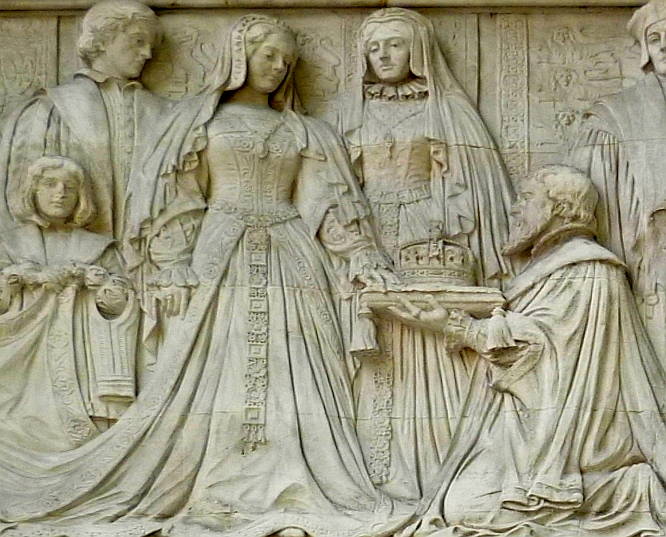
Frieze by Henry Charles Fehr (1867-1940). Middlesex Guildhall, Parliament Square, London. Architect: J. S. Gibson and Partners. Portland Stone. 1906-1913. The "new" Guildhall building of this date features "[f]ine sculptured details with deep, figured, relief frieze above and to the sides of the entrance extending over canted bay-towers" ("Middlesex Guildhall"). Above the arch over the main entry, Henry III, standing on the left, grants a charter to the Abbey of Westminster, with church and abbey hierarchy and acolytes in attendance. The Guildhall was originally built on the site of Westminster Abbey's Sanctuary Tower and Belfry.


Left: Close-up of Henry III. It is amazing to see this much detail, for example, even in the "embroidery" of the robes. Peter Cormack talks of the "crispness" that characterises Fehr's sculptures (108). Some of this must be put down to his highly skilled Italian stone-carver, Carl Domenico Magnoni (1871-c.1950). Right: King John with the Barons at Runnymede, where he affixed his seal to the Magna Carta. The King, looking suitably flattened, is flanked” by two churchmen. Some monks are also present.


Left: Closer view of some of the Barons with their pages, looking stalwart and resolute. In the middle is one of the monks, holding a Bible. Right: This is the scene to the right of the entrance, matching King John and the Barons on the other side. It shows Lady Jane Grey being offered the crown” by her father-in-law, the Duke of Northumberland. Her husband stands next to her. These three would all be considered traitors, and beheaded — a scene chosen, perhaps, as a warning. Again, the amount of detail is stunning.


Left: Close-up of Lady Jane Grey, her hand close to the proffered crown. Upper right: Two of the well-endowed angels, with thickly feathered wings, that serve as corbels to the balcony projecting on the Broad Sanctuary side of the building. Looked at from this angle, they are rather like ships' figureheads. One bears a shield with scales, the symbol of justice; the other holds an orb and a sceptre, the symbols of power. These and the other sturdy, earthy angels come as a surprise after the courtly scenes on the frieze, but are very much in keeping with the neo-Gothic elements of the building. Note, however, that their faces are the usual dreamy, Art Nouveau faces that we find in other Fehr sculptures (e.g. Peace on his Leeds war memorial).


Left: Tiny keystone figures peep down over the windows, these two apparently representing sculpture and painting. This kind of playfulness, which is reminiscent of William Burges, is quite unusual on a civic building, and very entertaining. Right: A craftsman with a small model of a temple in one hand, and what looks like a window-trowel in the other. His expression is one of stern concentration.
Related Material
Photographs by Robert Freidus and Jacqueline Banerjee. Formatting by George P. Landow, 2011. [You may use these images without prior permission for any scholarly or educational purpose as long as you (1) credit the photographer and (2) link your document to this URL in a web document or cite the Victorian Web in a print one.]
Bibliography
Cormack, Peter. "Gothic 'with a difference': Sculpture and Decorative Arts at the Supreme Court of the United Kingdom." The Supreme Court of the United Kingdom: History, Art, Architecture. Ed. Chris Miele. London & New York. Merrell, 2010. 98-137.
"Middlesex Guildhall." English Heritage National Monuments Record, Images of England. Web. 3 July 2011.
A Self-Guided Tour of the Supreme Court, Crown Copyright 2010. Available at the Supreme Court.
"Supreme Court." H. C. Fehr (excellent site run” by Fehr's great-great-granddaughter). Web. 3 July 2011.
"The Supreme Court: External Stonework" (Supreme Court official site). Web. 3 July 2011.
The Supreme Court of the United Kingdom: Visitors' Guide and Map. Available at the Supreme Court.
Last modified 3 July 2011